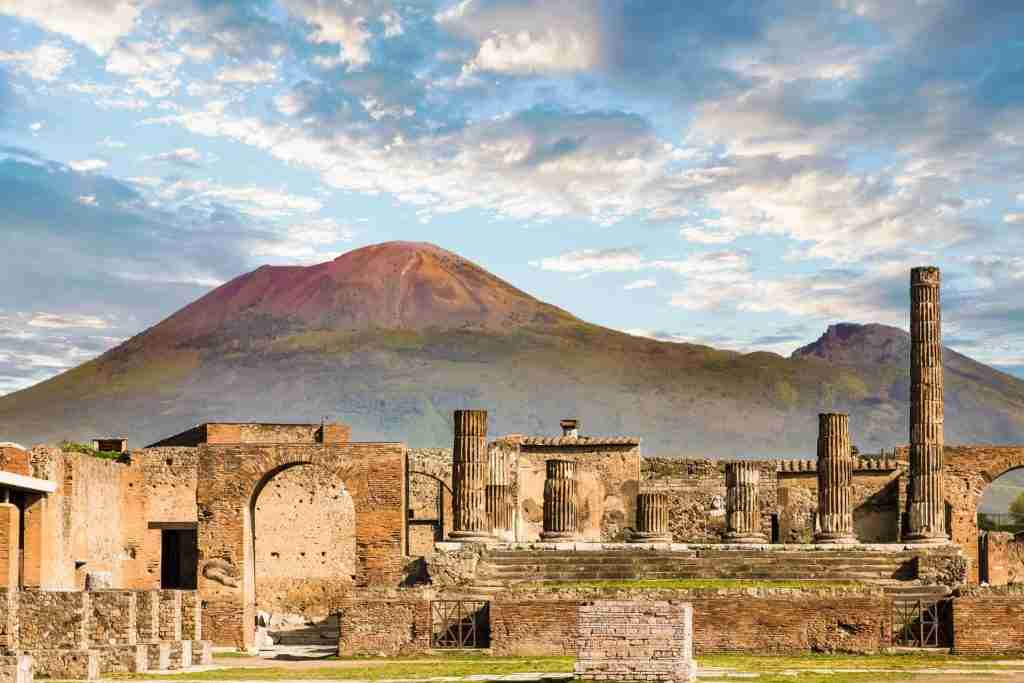“Mount Vesuvius has always been my domain. The hottest hells of the earth cannot touch our kind. Know true darkness by how it embraces your fire, your blood, or both, and beware the bright light of day”.
Joely Sue Burkhart
Defining Mount Vesuvius, connection to Pompeii, importance of studying Mount Vesuvius, and brief history – these are the key points that we will be discussing in this article. By now, you must have heard about the famous volcano, Mount Vesuvius – known for its preservation and annihilation of the ancient city of Pompeii.
But there is more to it that makes this geological giant fascinating, so let’s dive deeper.
Where is Mount Vesuvius?
Mount Vesuvius, located in the Campania region of Italy, is a well-known volcano that has erupted countless times, with the most famous one being the eruption in 79 AD that destroyed the city of Pompeii. It’s a stratovolcano, forming an opening in the earth’s crust where lava, volcanic ash, and poisonous gases escape. The volcano is known for being formed of two peaks, Vesuvius and Monte Somma, where the latter has a caldera or a crater, created following a previous eruption. The tragic connection to Pompeii, where the city was buried under ash and pumice, causing the death of thousands, makes Mount Vesuvius a crucial site for archeological studies. The historic tragedy has advanced our understanding of ancient civilizations and their ways of life, and it stands as a stark reminder of the sheer power of Mother Nature. Yet, the importance of studying Mount Vesuvius is not limited to the tragedy of Pompeii. It provides scientists and geologists with unique insights into the Earth’s geothermal activity, as well as valuable information on volcanic eruptions and their effects.
History of Mount Vesuvius
Mount Vesuvius has a long history, dating back over hundreds of thousand years, with its latest eruptions dating less than 10,000 years ago. Its first extremely destructive eruption was 25,000 years ago, but before that, it had many smaller explosions throughout its years. It is also home to rich volcanic soil, nourishing some of the most delicious wines and tomatoes – proving that not all things that come out of volcanoes are destructive. In the following sections, we will explore the formation of Mount Vesuvius, its history of eruptions, the tragic story of Pompeii, the impact of the volcano on society, and the lessons to help us survive another eruption. Keep reading!
Formation of Mount Vesuvius
As we said, Mount Vesuvius, the infamous volcano in the Campania region of Italy, is formed out of two volcanoes. The “main peak,” as we know it, is named Vesuvius, while the other, which is attached to it, is Monte Somma. The two volcanic structures are so connected that it is difficult to view them as separate entities. However, it’s vital to understand their individual structures as each volcano tends to have its separate mechanism. On top of Monte Somma lay what is known as a caldera or crater, created following a previous eruption. Mount Vesuvius grew out of the top of Monte Somma, over time becoming its main peak. As the successive volcanoes grew, they layered upon one another, creating a composite volcano. Examining Mount Vesuvius, scientists have found ancient debris of rock that confirms the mountain’s age to be around 300,000-400,000 years old. Although Vesuvius is currently classified as an active volcano, it’s neither erupted frequently. Before the most famous eruption in 79 A.D. that destroyed Pompeii, there were around eight gigantic and noteworthy eruptions in the last 17,000 years, with numerous smaller ones in-between them.
Its first extremely destructive eruption was 25,000 years ago, but before that, it had many smaller explosions throughout its years.
Despite its unpredictable nature, Mount Vesuvius is surrounded by thriving businesses. Volcanic soil is famed to be super fertile, and the lush land surrounding the city has always sustained agriculture. Also, the vineyards surrounding Mount Vesuvius are famed all over Italy as it yields delicious wine. The tomatoes grown on the mountain are also of high quality. It’s crucial to study Mount Vesuvius and understand its nature to be prepared for possible future eruptions. In the next section, we’ll explore the horrors of the past while discovering the impact this natural disaster has on society.

Mount Vesuvius: history of Eruptions
Before the infamous eruption of Pompeii, Mount Vesuvius had erupted numerous times, leaving a trail of destruction. While the 79 AD incident is the most well-known, there were various noteworthy volcanic eruptions over the years. Scientists have evidence of about eight massive eruptions in the past 17,000 years, with smaller ones in between. The volcano’s first destructive eruption took place 25,000 years ago followed by a series of smaller explosions. However, the people of Pompeii failed to recognize the tremors that often shook the city as precursors to a devastating volcanic eruption. They had grown accustomed to these tremors and believed them to be harmless. The eruption of 79 AD was Mount Vesuvius’s most infamous eruption. It erupted on August 24th, AD 79, with Pliny the Younger recording the events—the first detailed account of a volcanic eruption in history. The eruption expelled pumice, ash, and toxic gases, and the initial explosion lasted about 24 hours. The intense heat and explosive force of the eruption caused suffocation, injury, and a shower of volcanic debris that buried the surrounding towns, including Pompeii, Herculaneum, and Stabiae. The eruption of Mount Vesuvius that destroyed Pompeii is considered one of the most catastrophic events in history. Thousands lost their lives, and the once-thriving city was buried under ash, pumice, and debris. The volcanic material compacted the city, creating a time capsule that preserved it for over 1,500 years.
Pliny the Younger’s account of the eruption has provided invaluable information about this disaster. He observed the eruption from the Bay of Naples, describing the event from a distance. His writings have been used by modern scientists to understand how the eruption occurred and what it entailed.

The survivors could only watch as pyroclastic flows engulfed the city, causing mayhem and destruction. It wasn’t until nearly 1,700 years after the event that chemist Michelangelo Grimaldi located the buried city, leading to its rediscovery in 1748. The discovery gave insight into the life and customs of the people before the eruption. Body casts of the victims revealed how they died, while ancient artefacts and buildings have contributed to our understanding of Roman society. Thanks to the eruption of Mount Vesuvius, we have an extraordinary historical record of life in ancient Pompeii. In spite of the destruction caused by the 79 AD eruption, Mount Vesuvius is now an essential site for scientific research. While it has been silent since the 1940s, the volcano is still considered active and is monitored closely. Its eruptions remind us of the raw power of nature, and people are now better equipped to predict and prepare for future disasters.
The Tragic story of Pompeii: life before the Eruption
Pompeii, an ancient Roman city located near modern-day Naples, was a thriving and bustling metropolis with a population of around 20,000 people. The city was known for its beautiful architecture, art, and its rich cultural heritage. Pompeii was an important commercial center, with a port that connected it to the rest of the Mediterranean world. Life in Pompeii was full of vigor and activities, which is evident by the number of public buildings like theatres and markets.

The eruption and its aftermath
On 24th August 79 AD, Mount Vesuvius erupted, sending a massive column of ash, rocks, and gas into the air, which rained down on the unsuspecting inhabitants of Pompeii. The eruption was so violent that it buried the whole city under a layer of ash and pumice stones, killing everyone who didn’t manage to escape in time. The people of Pompeii had no chance to flee the disaster because there was no way of predicting the eruption at the time. It is estimated that around 2,000 people died on that fateful day.
The rediscovery of Pompeii
Pompeii was buried under volcanic ash for over 1,700 years until it was rediscovered in the 16th century. The city’s rediscovery was not easy, as it required extensive excavation work. In the 18th century, a series of excavations began, unearthing the streets, buildings, and public spaces of Pompeii. Today, Pompeii is one of the most popular tourist attractions in Italy and has become a UNESCO World Heritage Site.

A look into the preserved city
Visiting Pompeii today provides a glimpse of what life was like in ancient Roman times. The city’s preserved buildings, streets, and public spaces provide an insight into the culture and daily life of the city’s inhabitants. Walking through the ancient city streets, one can see the public bathhouses, the amphitheaters, the shops, and the private homes of the people who lived during the Roman times. The most famous building in Pompeii is the House of the Vettii, which is a well-preserved example of a rich merchant’s house during the Roman era. The city’s artifacts, including painting and mosaics, are also on display in the city’s museum.
In conclusion, the eruption of Mount Vesuvius in 79 AD was a devastating event that changed the course of history. However, the rediscovery of Pompeii gave us an opportunity to glimpse ancient Roman life and culture. Today, Pompeii serves as a reminder of the power of nature and the importance of history.
The Impact of Mount Vesuvius on society
The deadliest eruption in the history of Mount Vesuvius has caused much devastation, but there have been positive impacts too. One significant impact is the volcanic soil that is incredibly fertile due to the mineral-rich ash and lava deposits. This soil has supported the growth of many plants around Vesuvius, including the famous Pomodorino del Piennolo del Vesuvio tomato, which has been awarded protected geographical status.

The volcanic soil is also ideal for vineyards, and the areas surrounding the mountain produce several wines that are renowned for their quality.
Aglianico, a red grape variety, Fiano and Greco di Tufo, two white grape varieties, are some of the most popular wines grown on Vesuvius. The porous nature of the hardened lava makes it perfect for storing water in the ground, acting like a sponge. Due to this, many of the vineyards don’t require any artificial irrigation during the summer months.The impact of Mount Vesuvius on society is not just limited to agriculture. The mountain has shaped the culture and history of the surrounding areas. The artifacts and archeological discoveries of Pompeii have given us glimpses of life in ancient Rome, and we have evidence of the devastation caused by the 79 AD eruption.

While the eruption of Mount Vesuvius had destroyed the city of Pompeii, it has also helped to preserve a snapshot of history, allowing us to study, learn and understand our past better.
The mountain has also influenced the architecture and urban design of the region. Many of the villas and houses in the areas around the mountain possess stunning facades and unique designs that are specific to the region. Additionally, the presence of the volcano has had an impact on the infrastructure in the area. The railway line that connects Naples to Sorrento was built to make transportation easier for both tourists and residents.
In conclusion, the volcanic soil, wines, and architecture are some of the most notable impacts that Mount Vesuvius has had on the surrounding region. It is critical to understand the impacts of the volcano and the insights that we can gain from studying it. The past volcanic disasters have taught us the importance of preparedness and mitigation during natural disasters. So, it is essential to continue efforts to learn and prepare for the possibility of future eruptions, which will minimize the impact of the disasters and keep the local communities and their inhabitants safe.

Vesuvius Eruption 2023
The region, known for its ancient volcanic craters, has experienced a significant increase in seismic activity over the past year, particularly in recent months.
Since the end of September 2023, concerns are on the rise regarding the possibility of a volcanic eruption near Naples following the most powerful earthquake in four decades.
Evacuation plans are now in the works due to heightened activity in the Campi Flegrei region, which experts had previously warned was in a precarious state in 2023. Experts have suggested that the best-case scenario would be for this heightened activity to subside, similar to what occurred after a prolonged period of unrest in the early 1980s.
The worst-case scenario, however, could entail an eruption resembling the one that took place in 1538, resulting in the formation of a series of small hills and craters.
Surviving another eruption
So, given the history of Mount Vesuvius, it’s clear that the next eruption is not a matter of if, but when. Seismologists continuously monitor the volcano, and while it is reportedly overdue for an eruption, the next one is impossible to predict accurately. That doesn’t mean one shouldn’t be prepared. The impact of Mount Vesuvius on the surrounding areas during an eruption is catastrophic. Not only does lava destroy everything in its path, but the ash and gases emitted from the volcano can cause severe respiratory issues and lead to the downfall of nearby buildings. Predicting the potential impact on society is challenging, but educating communities in the surrounding area about the dangers and offering helpful tips such as avoiding contact with ash and seeking shelter immediately can make a difference in minimizing casualties. Lessons from the past also teach us the significance of being prepared. The tragic events of Pompeii are a reminder of the importance of having an evacuation plan and maintaining emergency provisions. New technologies and constant research have helped develop better methods to study volcanos, including Mount Vesuvius. It’s essential to keep up-to-date on the latest discoveries and innovations to make informed decisions that save lives.
There are also measures being taken to reduce the impact of future eruptions.
The Italian government has developed evacuation plans and shelters in case of a volcanic eruption, and the European Union has designated Vesuvius as a high-risk volcano, leading to more resources being devoted to its monitoring.
It’s crucial to support these efforts and recognize that even small preventive measures can make a difference. There’s no doubt that Mount Vesuvius’ impact on surrounding areas cannot be underestimated, and preparation is key to surviving another eruption. While predicting future eruptions accurately is an impossible task, educating surrounding residents, learning from past disasters, and taking steps to reduce the impact of future eruptions can certainly help save lives and minimize damage. One thing is certain – Vesuvius will erupt again, and we must be prepared.
The Bottom Line
Studying Mount Vesuvius and its history is crucial to understanding the impact of volcanic activity on society. The tragedy of Pompeii serves as a reminder of the devastating effects of natural disasters. Preparedness and knowledge can help mitigate the effects of future eruptions. In conclusion, while Mount Vesuvius holds a place in history as a destructive force, it also provides evidence of the resilience of nature and the ability of communities to rebuild after disaster strikes. Keep following us to find out more interesting facts about Italy, history, and to discover our LCN App.

